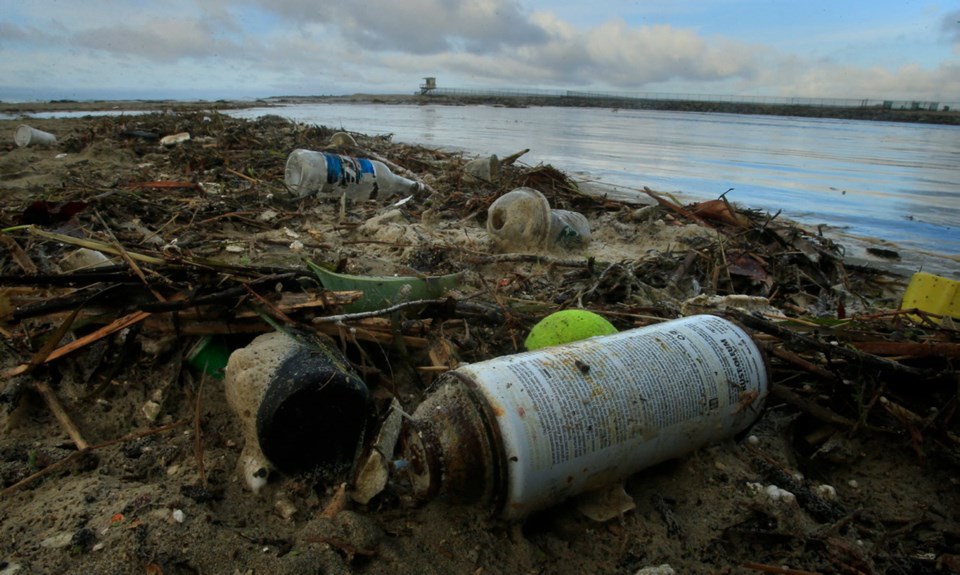SACRAMENTO, California — It took years of activist campaigns to turn the plastic bag into a villain, and hard-fought legislation to reduce its presence in oceans and waterways. Now, environmentalists and lawmakers are deploying similar tactics against a new generation of plastic pollutants.
There are drinking straws, which as a viral video shows can get stuck in a sea turtle’s nose. The hundreds of thousands of bottle caps that wind up on beaches. And the microfibres that wash off polyester clothes, making their way into the ocean, the stomachs of marine life and ultimately our seafood.
Each is the subject of statewide legislation under debate in Sacramento, as California again considers new environmental law that’s at once pioneering and controversial.
Their action comes as plastic takes centre stage as the environmental concern du jour.
There could be more plastic by weight than fish in the world’s oceans by 2050, according to a widely cited World Economic Forum report. A recent University of California, Davis study sampled seafood sold at local markets in Half Moon Bay and found that one-quarter of fish and one-third of shellfish contained plastic debris.
A survey comparing 150 tap-water samples from five continents found synthetic microfibres in almost every sample — 94 per cent in the United States. The Great Pacific Garbage Patch is at 1.8 trillion pieces of trash, most of it microplastic, and counting.
The European Commission on Monday proposed new across-the-board rules, including a ban on single-use plastic products “where alternatives are readily available and affordable.”
The call to break the world’s disposable-plastic habit is resonating, especially in California. More than half a dozen bills aimed at plastic pollution were introduced in Sacramento this year alone — by both coastal legislators and more moderate inland colleagues who see the potential damage not just in oceans but also rivers, lakes and the state’s water supply. No one, they said, wants to drink a glass of water and wonder if they’re also downing a glass of plastic.
The state, after all, was the first in the nation to ban single-use plastic bags, setting the stage for others to follow. When a state law barred exfoliating beauty products with plastic microbeads, the industry impact was so large the ban was adopted at the national level in former U.S. president Barack Obama’s final year.
“What we do has not just national, but international implications. We’re the fifth-largest economy in the world,” said Assembly Majority Leader Ian Calderon, a Democrat who introduced a bill this year that bars sit-down restaurants from providing plastic straws unless a customer requests one. “You better believe that if we do something and it works here, everyone’s going to adopt it.”
Calderon has also teamed up with Democratic Assemblyman Mark Stone, a longtime environmental leader, on a law that would prohibit retailers from selling single-use plastic bottles with caps that do not remain tethered to the container after opening.
A bill by Democratic Assemblyman Richard Hershel Bloom, who had authored the microbeads bill and is a co-author on the straws and caps bills, requires all new clothing made with more than 50 per cent synthetic material have a label that warns of microfibre shedding during washing.
All three have passed committee and are expected to go to the assembly floor this week.
Synthetic fabrics such as polyester, nylon, acrylic and spandex are everywhere, and so are their sheddings. A Patagonia study found that a microfleece jacket could release more than 1,000 milligrams of microfibres per wash. Laundry machines today are not equipped to filter out microfibres, usually less than five millimetres long, and up to 40 per cent of microfibres pass through wastewater treatment plants.
The study, conducted with the University of California, Santa Barbara, found that a single treatment plant discharged 3.73 billion microfibres, estimated at 80 kilograms, per day.
The state’s plastic bag ban, which set off one of the fiercest lobbying battles in 2014, took eight years and has paved much of the way for today’s bills.
In 2016, plastic-bag makers spent $6 million US in an effort to convince voters to overturn the bag ban through two ballot measures. Californians upheld the ban, which went into effect at the end of that year.
Shoppers have adapted with little grumbling and the economic effects so far have not been dramatic, advocates say. The decline in bags found on beaches has been substantial: The number of plastic bags collected on the most recent annual Coastal Cleanup Day dropped more than 60 per cent compared with 2010.
Justin Malan of Ecoconsult, which works with the Clean Seas Lobbying Coalition, says California has come a long way from the days when it was a political “pitchfork battle against just about everybody except the coastal advocates.”
“This issue has become much more mainstream,” Malan said. “We don’t have to fight some of those earlier environmental fights.”
Helping the momentum are the many cities that have already banned plastic straws: Malibu, Santa Monica, Manhattan Beach and San Luis Obispo.
Considering the magnitude of the plastic problem, however, this item-by-item, city-by-city approach isn’t a long-term solution, Heal the Bay president Shelley Luce said.
“It’s still cheaper for the manufacturer and the consumer to use single-use disposable plastic everything than it is to use a bamboo replacement or metal replacement or something that is more easily reused or recycled,” Luce said. “We have to think about incentivizing new designs and helping manufacturers move toward new materials.”
Sara Aminzadeh, a state coastal commissioner and executive director of California Coastkeeper Alliance, agrees that the more complete solution is part cultural, part market-driven.
“Companies will need to take responsibility for the amount of plastic that they’re producing,” she said, “and we need to proactively acknowledge that and include them as part of the solution.”



